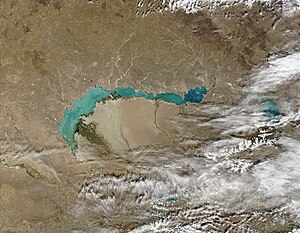Lake Balkhash
| Lake Balkhash | ||
|---|---|---|

|
||
| Satellite image of Lake Balkhash. Below left is the tributary of the Ili | ||
| Geographical location | eastern Kazakhstan | |
| Tributaries | Ili , Qaratal , Aqsu , Lepsi , Ajagös | |
| Drain | none | |
| Places on the shore | Balqash | |
| Data | ||
| Coordinates | 47 ° N , 75 ° E | |
|
|
||
| Altitude above sea level | 342 m | |
| surface | up to 18,428 km² | |
| length | 620 km | |
| width | 70 km | |
| volume | 106 km³ | |
| scope | 2,385 km | |
| Maximum depth | up to 26 m | |
| Middle deep | 5.8 m | |

|
||
| The shore of Lake Balkhash | ||
The Lake Balkhash ( Kazakh Балқаш көлі / Balqasch köli ; in German "Swamp Lake"; Russian Балхаш ) is a lake with no outflow , which lies in the desert steppe of eastern Kazakhstan ( Asia ).
geography
The lake, which is up to 18,428 km² in size, is located in a basin between the Kazakh threshold and the Seven Streams . It has an elongated sickle shape . Its catchment area is approximately 413,000 km². The strongly indented south bank is characterized by numerous islands and peninsulas. The size of Lake Balkhash varies depending on the water level. It is up to 620 km long and up to 26 m deep; its water surface is at a maximum of 342 m . The average water depth is 5.8 m. The lake is divided in two roughly in the middle by a narrowing, the 4.5 km wide Uzun-Aral Strait . Its eastern part is very salty (> 7%), the western part contains fresh water or only slightly salty water (0.5–1.5%) - depending on the fluctuations in the water level. The low salinity of the western part is caused by its large tributaries and favored by the low water exchange between the western and eastern parts.
The largest city on the coast is Balqash . The main tributaries are the Ili and the Qaratal .
The main railway lines from Almaty to Karagandy and from Almaty to Barnaul run along the east and west banks of the lake .
Ecological situation
Like the Aral Sea , once the fourth largest lake in the world, Lake Balkhash is threatened with drying out. On the one hand, this is due to the fact that the Soviet Union diverted a lot of water from the inlets in the 1960s to irrigate cotton plantations. In 1970 the Qapschaghai dam (reservoir area> 1800 km²) was completed on the Ili , which caused the lake level to drop by a further 2 m. In addition, there is the strong urbanization of the Chinese autonomous region of Xinjiang and the correspondingly increasing demand for water, which in turn is covered by the Ili that rises there. Given the traditionally poor relations between Kazakhstan and China, there is little hope of an amicable settlement.
Plague hypothesis
For a long time, the area around Lake Balkhash was considered the origin of the plague epidemics of the Middle Ages (see History of the Plague ). Gravestones from the years 1338/1339 not far from Lake Balkhash in this area describe the symptoms of the plague. A strikingly high mortality rate was found in Christian catacombs during this period. When comparing the genome at the London plague cemetery, however, it turned out that the plague epidemic in the sixth century can also be traced back to the same pathogen, cf. Genome decoding .
literature
- Richard Stone: Last chance for Lake Balkhash. In: Süddeutsche Zeitung, July 31, 2012, No. 175, page 18.
Web links
Individual evidence
- ↑ a b Lake Balkhash - ASI-54. ( Memento of January 8, 2018 in the Internet Archive ) Entry in the World Lake Database, accessed January 20, 2014.
- ↑ http://newsderwoche.de/welt/asien/2507-der-balchaschsee-nahert-sich-dem-ende-seiner-200-tausend-jahrigen-geschichte.html
- ↑ Klaus Bergdolt: The Black Death in Europe: The Great Plague and the End of the Middle Ages. CH Beck, 2017. ISBN 3406628850 , ISBN 9783406628856 , chap. 8. ( Preview online on Google Books )
- ↑ David Herlihy: The Black Death and the Transformation of Europe. Berlin 1998, pp. 18-28.
